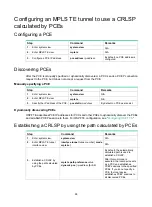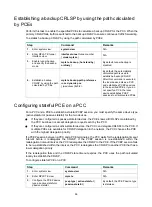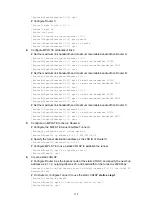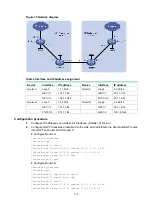
105
An automatically created bypass tunnel can protect multiple primary CRLSPs. A bypass tunnel is
unused when the bypass tunnel is not bound to any primary CRLSP. When a bypass tunnel is
unused for the period of time configured by the
timers removal
unused
command, MPLS TE
removes the bypass tunnel.
To configure auto FRR on the PLR:
Step Command
Remarks
1.
Enter system view.
system-view
N/A
2.
Enter MPLS TE view.
mpls te
N/A
3.
Enable the auto FRR feature
globally.
auto-tunnel backup
By default, the auto FRR feature is
disabled globally.
4.
Specify an interface number
range for the automatically
created bypass tunnels.
tunnel-number min
min-number
max
max-number
By default, no interface number
range is specified, and the PLR
cannot set up a bypass tunnel
automatically.
5.
(Optional.) Configure the
PLR to create only
link-protection bypass
tunnels.
nhop-only
By default, the PLR automatically
creates both a link-protection and
a node-protection bypass tunnel
for each of its primary CRLSPs.
Execution of this command
deletes all existing
node-protection bypass tunnels
automatically created for MPLS
TE auto FRR.
6.
(Optional.) Set a removal
timer for unused bypass
tunnels.
timers removal unused
seconds
By default, a bypass tunnel is
removed after it is unused for
3600 seconds.
7.
(Optional.) Return to system
view.
quit
N/A
8.
(Optional.) Enter interface
view.
interface
interface-type
interface-number
N/A
9.
(Optional.) Disable the auto
FRR feature on the interface.
mpls te auto-tunnel backup
disable
By default, the auto FRR feature is
enabled on all RSVP-enabled
interfaces after it is enabled
globally.
Execution of this command
deletes all existing bypass tunnels
automatically created on the
interface for MPLS TE auto FRR.
Configuring node fault detection
Perform this task to configure the RSVP hello mechanism or BFD on the PLR and the protected node
to detect the node faults caused by signaling protocol faults. FRR does not need to use the RSVP
hello mechanism or BFD to detect the node faults caused by the link faults between the PLR and the
protected node.
You do not need to perform this task for FRR link protection.
To configure node fault detection:
Step Command
Remarks
1.
Enter system view.
system-view
N/A
















































